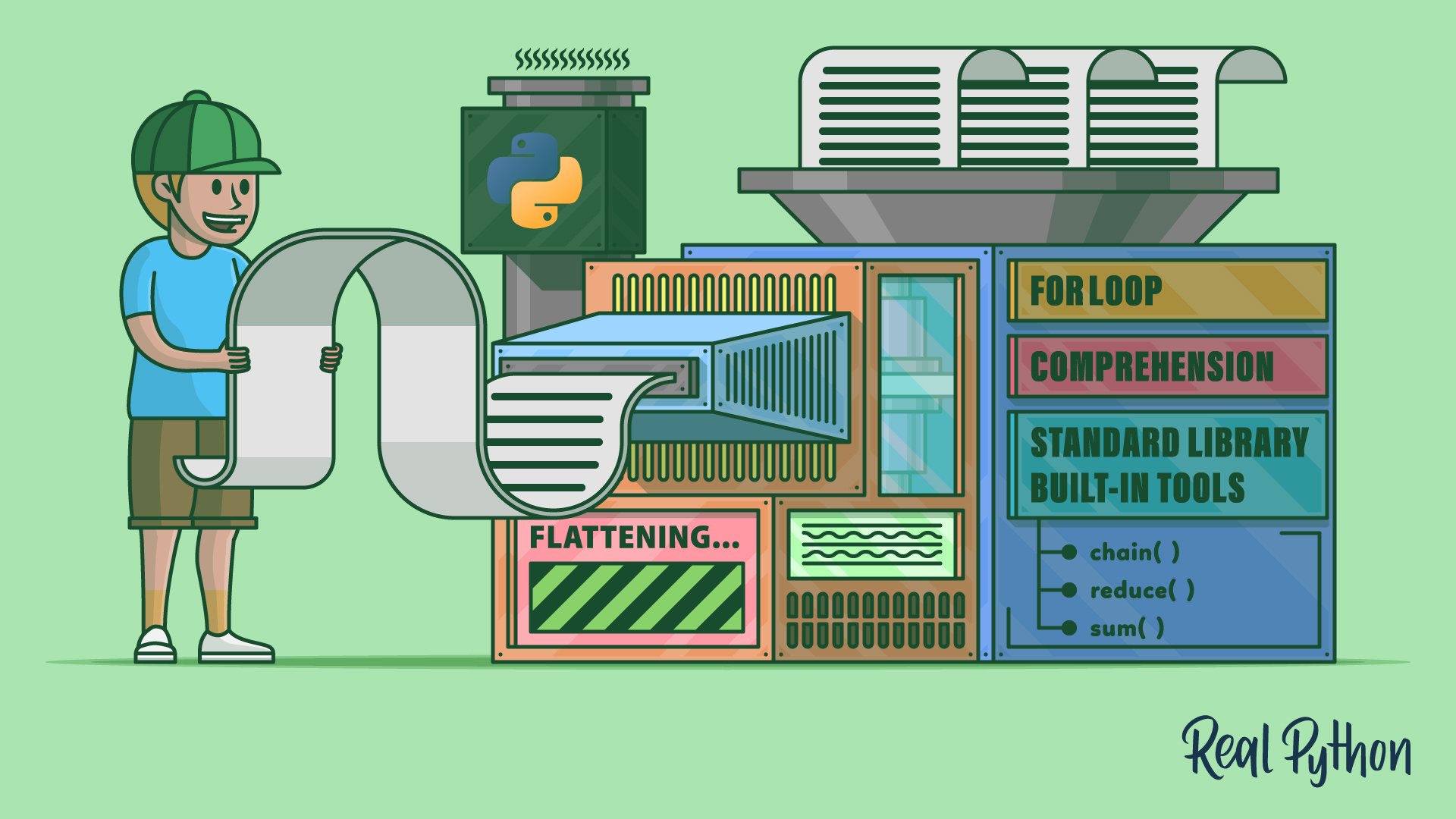Flatten a List of Lists in Python: A Complete Guide
Learn various Pythonic techniques to efficiently flatten a list of lists into a single, flat list for easier data manipulation.
Learn various Pythonic techniques to efficiently flatten a list of lists into a single, flat list for easier data manipulation.
In Python, you might encounter situations where you have a list containing other lists, and you need to combine all the elements into a single, flat list. This operation is called "flattening" a list of lists. Let's explore different methods to achieve this.
Let's say you have a list of lists like this:
list_of_lists = [[1, 2, 3], [4, 5], [6, 7, 8]]You want to "flatten" this into a single list containing all the elements: [1, 2, 3, 4, 5, 6, 7, 8]. Here's how you can do it:
1. Using Nested Loops:
flat_list = []
for sublist in list_of_lists:
for item in sublist:
flat_list.append(item)list_of_lists.item and appends it to the flat_list.2. Using List Comprehension:
flat_list = [item for sublist in list_of_lists for item in sublist]sublist and then each item within the sublist, adding each item to the flat_list.3. Using sum():
flat_list = sum(list_of_lists, [])sum() function is typically used for adding numbers.[] as the second argument (the starting value), you can use it to concatenate lists together.4. Using itertools.chain.from_iterable():
import itertools
flat_list = list(itertools.chain.from_iterable(list_of_lists))itertools.chain.from_iterable() creates an iterator that effectively "chains" together all the elements from the sublists.list() to convert this iterator into a list.These are some of the common ways to flatten a list of lists in Python. Choose the method that you find most readable and efficient for your specific use case.
This Python code demonstrates four different methods to flatten a list of lists: nested loops, list comprehension, the sum function, and the itertools.chain.from_iterable function. Each method is shown with example usage and the resulting flattened list is printed.
list_of_lists = [[1, 2, 3], [4, 5], [6, 7, 8]]
# 1. Using Nested Loops:
flat_list_loops = []
for sublist in list_of_lists:
for item in sublist:
flat_list_loops.append(item)
# 2. Using List Comprehension:
flat_list_comprehension = [item for sublist in list_of_lists for item in sublist]
# 3. Using sum():
flat_list_sum = sum(list_of_lists, [])
# 4. Using itertools.chain.from_iterable():
import itertools
flat_list_itertools = list(itertools.chain.from_iterable(list_of_lists))
# Printing the results:
print("Original list of lists:", list_of_lists)
print("Flattened using nested loops:", flat_list_loops)
print("Flattened using list comprehension:", flat_list_comprehension)
print("Flattened using sum():", flat_list_sum)
print("Flattened using itertools.chain.from_iterable():", flat_list_itertools)This code demonstrates all four methods of flattening a list of lists, providing clear explanations and output for each.
sum() might be the most readable.itertools.chain.from_iterable() is generally considered the most efficient, especially for large lists.flatten(): If you're working with NumPy arrays, the flatten() method provides a straightforward way to flatten them.itertools: The itertools module offers other functions like chain() that can be useful for similar tasks.sum(): While using sum() is concise, be aware that it might not be as efficient as other methods for very large lists.itertools.chain.from_iterable() method highlights the power of iterators in Python. Learning about iterators can significantly improve your data processing skills.list.extend() within a loop.| Method | Description | Code | Pros | Cons |
|---|---|---|---|---|
| Nested Loops | Iterates through each sublist and each item within, appending each item to a new list. | python<br>flat_list = []<br>for sublist in list_of_lists:<br> for item in sublist:<br> flat_list.append(item) |
Easy to understand for beginners. | Can be less efficient for large lists. |
| List Comprehension | A compact way to achieve the same result as nested loops. | python<br>flat_list = [item for sublist in list_of_lists for item in sublist] |
Concise and often more efficient than nested loops. | Can be less readable for beginners. |
sum() function |
Uses the sum() function with an empty list as the starting value to concatenate the sublists. |
python<br>flat_list = sum(list_of_lists, []) |
Short and simple. | Can be less efficient than other methods, especially for large lists. Not as intuitive for list manipulation. |
itertools.chain.from_iterable() |
Creates an iterator that chains together all elements from the sublists, then converts it to a list. | python<br>import itertools<br>flat_list = list(itertools.chain.from_iterable(list_of_lists)) |
Efficient, especially for large lists. Handles any iterable, not just lists. | Requires importing the itertools module. Might be less readable for beginners. |
This table summarizes the different methods for flattening a list of lists in Python, highlighting their code, pros, and cons. Choose the method that best suits your needs based on readability, efficiency, and familiarity with the techniques.
Flattening a list of lists is a common task in Python, and understanding the various methods available to accomplish this can greatly improve your code's efficiency and readability. Whether you choose nested loops for their simplicity, list comprehension for its conciseness, the surprising use of the sum() function, or the efficiency of itertools.chain.from_iterable(), selecting the right tool for the job depends on your specific needs and coding style. As you become more comfortable with these techniques, consider exploring additional methods and libraries, such as NumPy's flatten() function or other functions within the itertools module, to further enhance your data manipulation capabilities in Python.
 How to Flatten a List of Lists in Python – Real Python | In this tutorial, you'll learn how to flatten a list of lists in Python. You'll use different tools and techniques to accomplish this task. First, you'll use a loop along with the .extend() method of list. Then you'll explore other tools, including reduce(), sum(), itertools.chain(), and more.
How to Flatten a List of Lists in Python – Real Python | In this tutorial, you'll learn how to flatten a list of lists in Python. You'll use different tools and techniques to accomplish this task. First, you'll use a loop along with the .extend() method of list. Then you'll explore other tools, including reduce(), sum(), itertools.chain(), and more. How to Flatten a List of Lists in Python | Saturn Cloud Blog | As a software engineer you might find yourself working with complex data structures in Python One common task you might encounter is flattening a list of lists This means taking a list that contains other lists and turning it into a single flat list
How to Flatten a List of Lists in Python | Saturn Cloud Blog | As a software engineer you might find yourself working with complex data structures in Python One common task you might encounter is flattening a list of lists This means taking a list that contains other lists and turning it into a single flat list Flatten A List of Lists in Python - GeeksforGeeks | A Computer Science portal for geeks. It contains well written, well thought and well explained computer science and programming articles, quizzes and practice/competitive programming/company interview Questions.
Flatten A List of Lists in Python - GeeksforGeeks | A Computer Science portal for geeks. It contains well written, well thought and well explained computer science and programming articles, quizzes and practice/competitive programming/company interview Questions. Python: How to Flatten a List of Lists | In this tutorial, we'll go over examples of how to flatten a 2D (list of lists) list into one list. We'll use for loops, list comprehensions, recursive algorithms, as well as libraries like Numpy and functools.
Python: How to Flatten a List of Lists | In this tutorial, we'll go over examples of how to flatten a 2D (list of lists) list into one list. We'll use for loops, list comprehensions, recursive algorithms, as well as libraries like Numpy and functools. Python | Convert a nested list into a flat list - GeeksforGeeks | A Computer Science portal for geeks. It contains well written, well thought and well explained computer science and programming articles, quizzes and practice/competitive programming/company interview Questions.
Python | Convert a nested list into a flat list - GeeksforGeeks | A Computer Science portal for geeks. It contains well written, well thought and well explained computer science and programming articles, quizzes and practice/competitive programming/company interview Questions. How do I make a flat list out of a list of lists in Python? | How do I make a flat list out of a list of lists in Python?
How do I make a flat list out of a list of lists in Python? | How do I make a flat list out of a list of lists in Python?